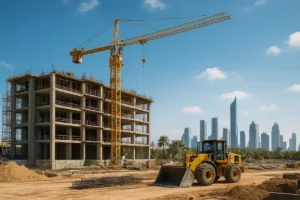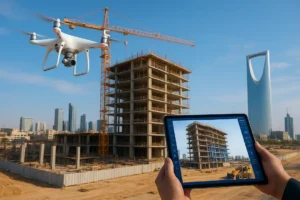From Heat to Salt: The Secrets Behind Durable Construction in Saudi Arabia
Construction in Saudi Arabia faces truly extraordinary challenges. With desert heat, constant sandstorms and corrosive salty air, building durable structures demands more than ordinary techniques. In this article you’ll discover how construction in Saudi Arabia adapts through smart materials and proven methods. We will explore what the climate throws at builders, how materials respond, and which design strategies help structures stand up to the heat, sand and salt.
Understanding the Climate and Its Impact on Construction in Saudi Arabia
The harsh environment
Construction in Saudi Arabia must contend with:
-
Very high temperatures, especially in summer where daytime highs in the desert regions exceed 45 °C.
-
Significant solar radiation and UV exposure that stress exterior materials.
-
Frequent sand-laden winds and sandstorms that abrade surfaces and clog systems.
-
Coastal salt exposure in many parts of Saudi Arabia, where sea-spray and high salinity air accelerate corrosion and material degradation.
-
Inadequate insulation or envelope design in many existing buildings, leading to high energy consumption for cooling.
Why the climate matters for construction
When you’re building in Saudi Arabia, climate directly affects:
-
Material selection: heat and salt shorten lifespan of many building elements.
-
Design of the building envelope: insulation, shading and orientation matter more.
-
Maintenance needs: more frequent upkeep may be required in harsh zones.
-
Lifecycle cost: buildings that ignore climate issues face high energy bills and early repairs.
By beginning with a clear picture of the environment, we can better appreciate why specific materials and methods are required.
Key Material Considerations for Construction in Saudi Arabia
Thermal resilience
In construction in Saudi Arabia, managing heat gain is crucial. Some material strategies include:
-
Use of supplementary cementitious materials (SCMs) like silica fume and fly ash in concrete to improve durability under high temperatures. For example, a study showed adding 5% silica fume reduced permeability by about 70% under hot-weather concrete conditions.
-
Use of reflective and cool-roof coatings to reduce roof surface temperatures and lower cooling loads.
-
High-performance insulation and radiant barriers in walls and roofs to reduce heat transfer.
Sand and wind abrasion
Sandstorms and wind-blown dust mean exterior surfaces and mechanical systems can degrade faster. Considerations include:
-
Hard-wear surfaces such as ceramic tiles, aluminum cladding or specialized coatings that handle abrasion better.
-
Design for ease of maintenance: replaceable panels or accessible systems for cleaning and repair.
-
Scheduled cleaning of air intakes, filters and shading devices to prevent clogging.
Salt and corrosion resistance
Coastal or near-coastal construction in Saudi Arabia faces the salt challenge. Key material and method strategies:
-
Use of corrosion-resistant steels (marine-grade stainless, hot-dip galvanised) and protective coatings on structural steel.
-
Use of weather-resistive membranes, vapour permeable barriers and detailing to prevent salt-laden air from entering cavities.
-
Careful concrete design to limit chloride ingress (important where sea-spray or salty ground is present).
Envelope and building-material durability
When choosing materials in Saudi Arabia’s extreme climate, durability is non-negotiable:
-
Materials must handle repeated thermal expansion/contraction cycles from day-night extremes.
-
Building materials must resist salt weathering and efflorescence — especially important in arid, coastal zone
-
The building envelope (walls, roof, glazing) must limit heat gain, avoid moisture entrapment and enable occupant comfort without exorbitant energy use.
Proven Methods & Design Strategies for Construction in Saudi Arabia
Passive design and orientation
When doing construction in Saudi Arabia, using passive architectural strategies reduces reliance on HVAC and improves sustainability:
-
Orient buildings to minimise direct sun exposure on large glazed surfaces. Overhangs, fins and shading devices help.
-
Use natural ventilation strategies where feasible — even desert regions can benefit from night-cooling and stack ventilation.
-
Roofs and walls can adopt high-albedo finishes to reflect solar radiation, lowering surface heat transfer.
High-performance envelope systems
-
Walls: Use insulation layers, thermal breaks, and high-quality air/ vapour barrier systems to prevent heat gain and moisture issues.
-
Roofs: Combine cool roof coatings with insulation and possible ventilated roof cavities to dump heat.
-
Windows/glazing: Use low-E coatings, high performance frames and shading to reduce solar gain.
Materials integration and maintenance planning
-
Health of a structure depends on maintenance. Especially with salt and sand exposure, routine inspection and upkeep are essential.
-
Use of modular or replaceable façade systems helps in high-abrasion zones.
-
Design joints, connections and details to tolerate movement from thermal expansion and to prevent water/salt ingress.
Foundation & ground-treatment methods
Desert soils, sabkha (salt flats) and reclaimed land are common in Saudi Arabia’s development zones:
-
Ground treatment and deep foundations are often required when building in sabkha or coastal reclaimed zones.
-
Attention to differential settlement, soil salinity and salt-laden groundwater is critical for structural integrity.
Conclusion
Construction in Saudi Arabia’s extreme climate demands thoughtful adaptation. By recognising how heat, sand and salt challenge building materials and systems, developers and engineers can choose the right materials & methods for success. Choosing high-performance materials, designing with the climate in mind, and maintaining structures appropriately allows buildings to stand the test of time. Whether you are building in Riyadh’s desert or along a salt-coastline, applying these strategies ensures your construction project is not just safer, but more efficient and sustainable too.



